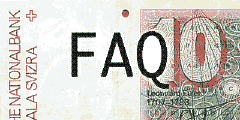

FTP and Web space at Kagi
Kagi now offers 5 Mb of FTP and Web space to our clients at an additional charge of 2% of the sales of their products. The web address would be:
www.kagi.com/(your kagi name here)/
Clients have direct FTP access to that space and can place downloadable software on our server. We still advice that you upload your software to the normal FTP sites to achieve the widest distribution. The advantage of using the Kagi FTP site is that you can update your software instantly without the nrmal delay imposed by major FTP sites.As for web space, there are several CGIs that are available for your use. We are currently running Count WWWebula, NetCloak, NetForms and e.g. from Apple.
Count WWWebula is a page access counter CGI. It is used to create the page counts shown on the bottom of this web page. To use Count WWWebula on this server, you first need to know the path to your web page. Take the full URL for the web page, for example:
http://www.kagi.com/joebob/default.html
and remove the server and remove the page type so that the path to the page is:
joebob/defaultThe counter CGI needs to know where to store your counts and we use the path to your page as the storage location after the dollar sign in the HTML.
Thus you would insert the following HTML into your page:
Since the beginning of time <IMG SRC="/cgi/counter/counter.acgi$joebob/default"
ALIGN=TOP ALT="Access Counter"> people have accessed this page.
and it would immediately start counting. If the page URL was
http://www.kagi.com/authors/myprogA/demo.html
You would insert this HTML:
Since the beginning of time <IMG SRC="/cgi/counter/counter.acgi$authors/myprogA/demo"
ALIGN=TOP ALT="Access Counter"> people have accessed this page.NetCloak is a fairly sophisticated CGI from Maxim and detailed demos and instructions at their web site. Think of NetCloak as adding additional HTML commands to your web page.
These commands allow you to hide and show portions of your HTML based upon many different attributes such as time of day or information that comes from the browser accessing your pages. We use this feature to add additional information to our web pages that can only be seen by those authorized to view that information. One web page but it appears differently depending upon who is accessing the page.
These commands also allow you to add dynamic information into your pages such as randomness, client browser information, counts, and to request information such as user name and passwords.
For example, you could use NetCloak to see what type of browse is being used and to show links to a SSL enabled web page when the browser supports SSL security. If you write programs for multiple platforms, you could use NetCloak to look at the browser computer type (Mac or Windows, etc) and then display that platform's software at the top of the list. Newton authors could point people to the appropriate download file format (stuffit/binhex or zip/uuencode) based upon their browser type.
As an example, the following HTML displays private information only to browsers coming from an AOL address.
<HIDE><SHOW_DOMAIN 198.81.>
Hello AOL user. Your IP address falls within the range used by AOL (198.81.0.0 to
198.81.255.255). Please note that AOL internet gateways lose incoming mail. We
estimate one in every 250. If you are wondering why you never received our email
reply, it is probably because AOL ate it. Please contact us and we will send the email
again. Thank you for your understanding.<p>
<SHOW>NetForms is another fairly sophisticated CGI from Maxim and detailed demos and instructions at their web site. Think of NetForms as your all purpose Web Form CGI. The CREATEDOC directive directs NetForms to build a new HTML page and save it with a specified filename. The INSERTFILE command directs NetForms to insert text into an existing HTML page or file instead of creating a new page. The TEXTSTORE command directs NetForms to store information from the form in a tab-delimited text file. The SENDMAIL command directs NetForms to send the result of the form processed as an e-mail message. There are other commands but in general it is a CGI that deals with web form data.
Modification Date: Friday, March 21, 1997